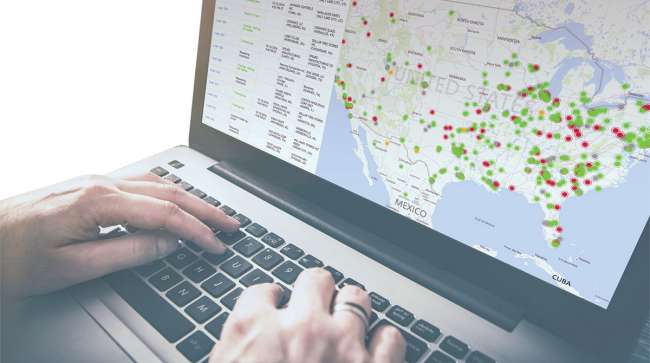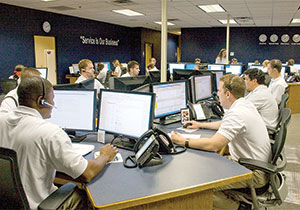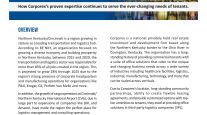Where’s That Shipment? Shippers Demand Precise Load Tracking to Improve Supply Chain Operations

The bar has been raised for freight visibility. Shippers are demanding more precise information about the location and status of their shipments, and transportation and logistics providers said they are using multiple load-tracking platforms to collect and share that information.
Shippers want regular updates on arrival times as well as status events.
“They’re asking for more data points,” said Mathew Elenjickal, CEO of FourKites, a provider of load-tracking technology. “On an average, we’re tracking at least 100 to 150 events per load.”

Shipment tracking technology photo by Schneider
Shippers and carriers are able to use this information to reroute trucks, schedule warehouse labor or adjust delivery windows to improve efficiency in the supply chain.
“It is taking data and using it in proactive execution and also making predictive accommodations,” Elenjickal said. “People are looking for real-time information because they can look at better labor management, dock management and just-in-time inventory.”
There are billions of data points that can be used to make predictions, better understand driver detention time and provide alerts, said Dan Cicerchi, vice president of load-tracking firm MacroPoint, which recently was acquired by Descartes Systems Group.
“There is a big appetite for data,” he said. “More shippers realize it is available, so then they want it.”
Modern load tracking goes beyond the basic location of the shipment.
“We not only provide location information but also the next layer of analytics on that information,” Cicerchi said. “Are they on time, ahead of schedule, behind schedule or not going to make it? And what are the implications around weather or traffic that are impeding the progress to a location?”
The load-tracking sector recently has seen some major acquisition activity.
Descartes bought MacroPoint in August for $107 million. A month later, Trimble purchased 10-4 Systems for an undisclosed sum.
This recent flurry of activity validates the importance of real-time data in the transportation industry, Cicerchi said.
Elenjickal said FourKites currently is not interested in potential mergers or acquisitions.

Schneider Logistics
Meanwhile, carriers and third-party logistics providers are incorporating more detailed shipment tracking into their operations.
“We’re always looking for ways to be more efficient on knowing where loads are and communicating it,” said Geoff Turner, CEO of Choptank Transport, a 3PL based in Preston, Md. “We can automatically get that information and flow it right through to our shippers.”
Choptank Transport has a proprietary tracking system and also uses technology from Trucker Tools, MacroPoint and Locus Traxx.
“Everyone wants to know where a package is at any time,” Turner said.
Although everyone is seeking greater freight visibility, it needs to be delivered in a way that makes life easier and eliminates the information black hole that once existed, said Erin Van Zeeland, senior vice president for Schneider Logistics Services, part of Green Bay, Wis.-based truckload carrier Schneider.
Transparency and data are power, especially when they are predictive in nature and allow those within the supply chain to know what to expect or how to alter the outcome, she added.
Schneider Logistics uses several systems to track location data, including FourKites, MacroPoint and Blue Prism.
“We use systems or capabilities that meet the needs and are easiest or noninvasive for the business — the shipper’s business, the carrier’s business or our business,” Van Zeeland said.
Shipment tracking information can help carriers maximize capacity, said Matt Cacace, chief operating officer for Smokey Point Distributing, a flatbed hauler based in Arlington, Wash.
“It helps in tightly booking and planning your trucks and maintaining customer service,” he said, adding that the company tracks loads with McLeod Software for its fleet and MacroPoint for other carriers it uses. Load positions also can be sent by electronic data interchange.
Smokey Point Distributing is part of Daseke Inc.
In today’s shipping environment, every load is time sensitive.
“Whether it is on the rail, moving across the city or across the country, somebody is waiting on that delivery,” said Andy Oleson, a product manager at Verizon Connect.
Shippers also may ask for customer information and details on the other stops or loads on the order.
“It is combining all of the information into an overall view of the business,” Oleson said. “Now you’re looking at it from a 10,000-foot view to see what makes the most sense.”
10-4 Systems pulls data from multiple sources, including its mobile phone-based tracking technology, a variety of electronic logging devices and transportation management systems as well as systems that track ocean vessels and railcars.
“I tell our customers they want to worry about how the soup tastes; they don’t need to worry about the ingredients. They’re not going to know where the data comes from. We normalize and standardize everything so it is seamless,” CEO Travis Rhyan said.
Rhyan said some shippers ask for detail down to the product identification number and information on inventory in transit.
“Knowledge of what is in transit gives you a more sophisticated way to manage inventory and just-in-time fulfillment rather than having a void until it arrives,” he said.
Shippers not only want to know the location of a shipment, but also who is hauling it, if it is a full or partial load and if everything needed was included. Rhyan said 10-4 also can help customers identify if a shipment is damaged or if the quantity doesn’t match the order. “We can do instantaneous piece-level refusal at the drop-off level,” he said.
At the same time, more transportation companies are utilizing tracking devices and sensors such as those from Orbcomm, which offers devices that can monitor trailers, railcars, chassis and containers, said Sue Rutherford, vice president of marketing. Those devices generate even more data shippers can tap into to monitor loads.
One major focal point for tracking data is addressing driver detention time.
Ben Wiesen, vice president of products and services for software provider Carrier Logistics Inc., said carriers are using this information to determine if a driver spent longer than expected at a given stop.
“If so, was it due to the customer causing a delay? If it was, we can charge extra revenue to recoup our cost,” he said.
Wiesen said he is seeing investment in more proactive tracking tied to the freight and not just the asset. CLI integrates with tractor-based devices and has a tablet application that drivers can use to provide updates.
The ubiquity of mobile devices is playing a big part in improving freight visibility.
Many technology developers are tapping into drivers’ phones, which can be particularly useful for brokers and logistics providers that can work with thousands of different carriers.
“They have to connect with people very quickly and very easily whether they’ve ever worked with them before or will again,” said Kevin Scullin, product manager for load board operator DAT Solutions.
FourKites, MacroPoint and 10-4 all use mobile phone locations.
XPO Logistics Inc. has developed Drive XPO, a mobile app for contract carriers and its own drivers that supports real-time visibility and load management in multiple modes.
“It integrates carrier operations with daily productivity tools on one platform,” XPO Chief Operating Officer Troy Cooper said.
Drive XPO displays load postings with details such as origin, destination, freight type, timing and requirements for special handling or equipment.
That information can save drivers time.

Load-tracking technology photo by Syfan Logistics
“The race to improve technology in our industry is in high-gear, and drivers benefit when new solutions come online,” Cooper said.
Drivers can use Drive XPO to manage loads, increase their refueling efficiency and plan truck stop layovers that best fit their schedule, he added.
DAT OnTime from DAT Solutions collects GPS data via a smartphone app and provides the information to brokers, Scullin said.
“The driver has a lot of control to start and stop the tracking,” Scullin said, adding that drivers also can mark a shipment at risk if they are concerned they won’t make it on time.
Trucker Tools, a provider of trip planning, shipment visibility and freight matching technology, offers a mobile driver app, Smart Capacity, which tracks drivers’ locations via mobile phones.
“We can track the pickup and delivery, where the load is and provide information on where the truck is if it is delayed,” said founder and CEO Prasad Gollapalli. Different shippers can request different visibility platforms.
McLeod Software integrates with a variety of those systems to make the process easier for carriers providing data.
“You don’t have to change your operational business to provide information. The system will do that for you,” said Robert Brothers, manager of product development for McLeod. “In our customers’ databases, it gets centralized so it doesn’t matter if it comes from one telematics provider or another.”

In our third episode of RoadSigns, Season Five, we ask: How Can Trucking Raise The Bar For Freight Visibility? Hear a snippet, above, and get the full program by going to RoadSigns.TTNews.com.
MacroPoint helps carriers identify how to best comply with shippers’ requirements. Options include connecting to the carrier’s ELD or dispatch system or using drivers’ cell phones. MacroPoint also has visibility into North American rail providers.
“We have a lot of out-of-the-box connections that make this very easy,” Cicerchi said. “We homogenize the data so it looks the same regardless of source.”
With all of this information now available, the challenge for many shippers is utilizing the data they receive.
“They all want the data, but we’re seeing that some of them don’t know what to do with it yet,” Choptank Transport’s Turner said.
However, some shippers have found ways to harness this data to improve operations.
“People thought shippers were going to use the information to beat up carriers, but we’ve seen the opposite. Our customers are using the data to create best-in-class scorecards and they’re trying to become better,” 10-4’s Rhyan said, adding that the data can help identify areas with high detention times.
Syfan Logistics uses tracking to support its key performance indicators.
“We also use the data to determine on-time pickups and deliveries,” said Diana Bullington, information technology director for Syfan Logistics, which is based in Gainesville, Ga., and uses tracking technology from MacroPoint, FourKites and Trucker Tools.





